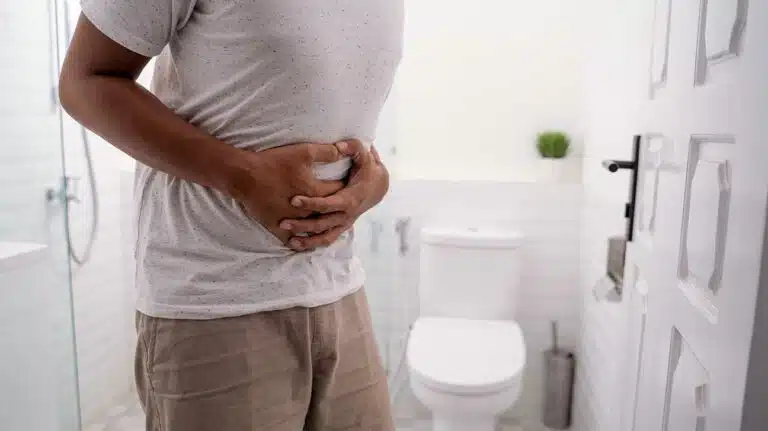Opioid-Induced Bowel Dysfunction | Prevalence, Symptoms, & Treatment

While opiates and opioid analgesics are addictive drugs of abuse, they’re also an important tool for treating those with severe pain.
However, both those who chronically abuse opioids and those who use them with a valid medical reason may experience a wide-range of side effects, including a potentially serious condition known as opioid-induced bowel dysfunction (OBD/OIC/OIBD).
What Is Opioid-Induced Bowel Dysfunction (OBD)?
Opioids act as strong central nervous system depressants and bind to μ-opioid receptors in the body. This calms pain and stress responses as well as mental and physical activity overall, which is why the effects of opioids are relaxing and calming.
Opioid-induced bowel dysfunction occurs when an individual taking opioid drugs (including morphine, fentanyl, oxycodone, methadone, and others) experiences the drug’s depressant effects on peripheral opioid receptors inside their lower gastrointestinal tract.
Opioids will tend to calm the movements of the GI tract, slowing down motility, impeding defecation, and increasing the transit time of material through the intestines with uncomfortable or sometimes dangerous complications.
Prevalence Of OBD
Experts have found it to be particularly challenging to properly estimate the incidence of OBD/opioid-induced constipation in those receiving opioid therapy.
This is likely due to the sheer variety of factors that can also contribute to constipation as well as the reluctance of many patients to seek treatment or report this symptom.
What The Research Says
According to a systematic review of randomized, placebo-controlled trials of oral opioid drugs (including weaker opioids like codeine and tramadol), 15% of clinical trial participants reported experiencing constipation.
In another study investigating the effects of high-potency transdermal fentanyl and sustained release oral morphine, 90% of the 256 participants with chronic non-cancer pain reported constipation.
Accordingly, it is safe to assume that a sizable baseline of those receiving intensive opioid therapy will experience some degree of opioid-induced constipation or OBD, with this likelihood increasing along with the strength and frequency of their dosage.
Symptoms Of OBD
OBD can severely damage a person’s overall quality of life. In fact, if severe interruptions in bowel function are not treated, this condition can become life-threatening.
More typical symptoms can include:
- chronic constipation
- alternating episodes of diarrhea and constipation
- decreased gastric emptying
- formation of hard, dry bowel movements
- fecal impaction
- stool leakage
- incomplete evacuation
- abdominal cramping
- abdominal pain
- spasms
- bloating
- nausea and vomiting
- gastric reflux
Some studies have even found that the pain and distress experienced by cancer patients suffering OBD was so great that a majority of respondents believed it outweighed the benefits provided by their pain meds.
Treatment Of Opioid-Induced Bowel Dysfunction
Treatment for OBD can take a variety of forms, including:
Non-Pharmacologic Interventions
Potential strategies for treating OBD without pharmaceutical changes include:
- increasing dietary fiber
- increasing fluid intake
- long walks and physical movement scheduled at the same time each day to encourage bowel movements
Pharmacologic Interventions
If non-pharmaceutical techniques aren’t sufficient, healthcare providers may turn to other options, including:
- laxatives (lubiprostone, among others)
- stool softeners
- antacids or proton pump inhibitors (for reflux)
- methylnaltrexone injection
- oral naloxone
- alvimopan (approved for the treatment of postoperative ileus)
It is important to note that laxatives also often come with side effects and adverse effects that should be taken into account.
Subcutaneous methylnaltrexone injection is a new therapy for OBD.
This treatment involves a solution of naltrexone (an opioid receptor antagonist that blocks the effects of opioid agonists) is regularly injected under the skin of the upper arm, abdomen, stomach, or thighs to relieve OBD without causing adverse events related to opioid withdrawal.
Low-dose oral naloxone treatment is another option, though this is more likely to reverse analgesia.
This is also true of alvimopan, yet another opioid antagonist that does not cross the blood-brain barrier and is approved to treat postoperative ileus, though it is sometimes prescribed off-label to treat OBD as well.
Reducing Or Changing Opioid Dose
OBD may be improved by changing drugs and reducing a person’s medication dosage to the lowest possible amount required for effective pain relief.
However, those in palliative care suffering from advanced cancer or other forms of advanced illness may not be able to tolerate a change in analgesia.
On the other hand, if a person is opioid dependent due to opioid abuse or addiction, or if they no longer require the use of opioid drugs for pain management, they can consider a medical detoxification program to work towards quitting opioid use entirely.
If you or a loved one live with opioid addiction and need help, please contact Ark Behavioral Health for information on our treatment options.
Written by Ark Behavioral Health Editorial Team
©2024 Ark National Holdings, LLC. | All Rights Reserved.
This page does not provide medical advice.
Food and Drug Administration (FDA) - Entereg Highlights of Prescribing Information
J Pain Symptom Manage - Low-dose oral naloxone reverses opioid-induced constipation and analgesia
Mayo Clinic - Methylnaltrexone (Subcutaneous Route)
Therapeutic Advances In Chronic Diseases - Opioid-induced constipation: advances and clinical guidance
Questions About Treatment?
Ark Behavioral Health offers 100% confidential substance abuse assessment and treatment placement tailored to your individual needs. Achieve long-term recovery.
100% confidential. We respect your privacy.
Prefer Texting?
Our friendly support team is here to chat 24/7. Opt out any time.







 Learn More
Learn More








